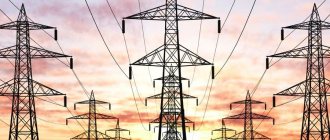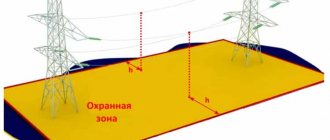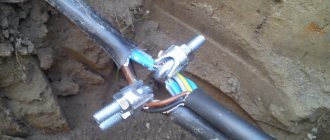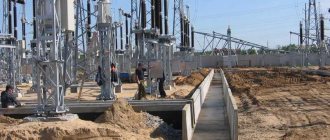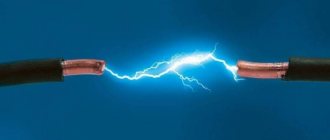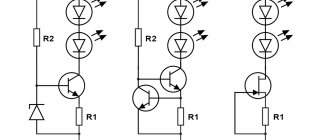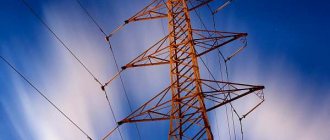Three-post corner support for 500 kV power lines
How to determine the voltage of a power line based on the appearance of the support, the number of wires and the length of the insulators? I started asking this question around the time the power lines started creeping into my photo collection. After reading various texts on the Internet, studying power grid maps and various other sources, even looking at the PUE a couple of times, I decided that it was time to write my own version of the instructions “How to determine the voltage on power lines.” With sparkling humor and pictures.
To begin with, it should be noted that the voltage on power lines can be found out from plates with various information, or simply inscriptions that can usually be found in one form or another on power line supports. But we are not here to read the inscriptions on the signs.
Lines 0.4 kV or 380 V
Wooden pole carrying 380 volts
Usually these are short poles, often wooden, 4 thin wires, small white porcelain insulators without ribs. Three wires form one three-phase circuit, the fourth wire is neutral. These are “last mile” power lines, so to speak, they directly power country houses, cottages, and various small consumers in rural areas. There is also a single-phase version of such power lines, with two wires, zero and phase, with a voltage of 220 volts.
Nothing special, overall.
Lines 10/6 kV
The poles are approximately the same as for 0.4 kV lines, usually concrete, but can also be wooden. There are usually 3 wires (one circuit), slightly larger insulators, green glass or black porcelain, with ribs. 2 plates can be used as insulators.
10 kV lines are more common than the dying out little by little 6 kV lines. 10 kV lines supply energy to small villages, or redistribute energy in larger settlements, for example, they go from substations 110/10/6 to transformer substations. Also, these are precisely 10 kV lines that usually stretch along railways; they are used there to power signaling devices and from them well-known branches go to package transformer substations.
10 kV line pole with transformer NOL-10
Two 10 kV supports with disconnectors
10 kV power line and branch to KTP
Double circuit end support 10 kV
On the railway (on the sides)
Classification of overhead lines
The voltage of power lines can be:
- Low voltage, 0.4 kilovolts, transmitting electricity within small settlements.
- Medium, 6 or 10 kilovolts, transmitting electricity over a distance of less than 10 km.
- High-voltage, 35 kilovolts, for power supply to small cities or towns.
- High-voltage, 110 kilovolt, distributing electricity between cities.
- High-voltage, 150 (220, 330, 500, 750) kV, transmitting energy over long distances.
The highest voltage on power lines is 1150 kilovolts.
35 kV lines
They are found, as a rule, only in rural areas, where they feed small 35/10/6 kV substations. In cities, 110 kV lines are usually used instead.
35 kV lines are noticeably different from 10 kV - the wires are more widely separated from each other, the insulators are larger, as a rule these are 3-5 plates. The supports are higher, and in addition to wood and concrete, they can also be made of metal structures, especially if there is more than one chain on the support.
Double circuit support 35 kV
Substation 35/10/6 kV
Cable power lines
Electricity metering cabinet: functions, classification, selection
What is a cable power line? This type of power lines differs from overhead lines in that the wires of different phases are isolated and combined into a single cable.
According to the conditions of passage
According to the conditions for passing the CL, they are divided into:
- Underground;
- Underwater;
- By buildings.
Cable structures
In addition to the fact that the cable can be located in water or land, part of it must pass through cable structures, which include:
- Cable channels;
- Cable camera;
- Cable mine;
- Cable well;
- Double floor;
- Cable gallery.
Cable well
This list is incomplete; the main difference between cable structures and others is that they are intended exclusively for installing cables along with fastening devices, power couplings and branches.
By type of insulation
The most widely used cable lines are those with solid insulation:
- Polyvinyl chloride;
- Oil-paper;
- Rubber-paper;
- Polyethylene (cross-linked polyethylene);
- Ethylene-propylene.
Liquid and gas insulation are less common.
Lines 110/150 kV
110 kV power lines are probably the most common type of power lines, especially in urban areas, after 10 kV, of course. They can be found both in the city and outside the city, or rather, it is generally difficult to find a place where they can not be found.
The 110 kV lines are already beginning to make some kind of impression, let’s just say that I associate the abbreviation transmission line with them in principle, although it is sometimes difficult to distinguish them from 220 kV lines. 110 kV lines are high supports made of metal structures or concrete, usually carrying 2 circuits (6 wires), single-circuit ones are also found, but less often. Insulators are always plates, 6-9 plates in a garland. I have never seen wooden supports for such stress, but they still exist. Each phase on 110 kV lines is made of one wire, i.e. no phase splitting is observed.
110 kV lines have a significantly larger security zone of 20 meters. There is also a new element - a lightning protection cable.
Regarding 150 kV lines, it seems that in Russia they are a little exotic, if they exist at all. At least this is the conclusion I came to by studying power grid maps, plates, and various similar documents.
110 kV power line supports near CHPP-2
110 kV power transmission line supports on the edge of the Tsaritsyno recreation center
Horned power transmission line support for 110 kV
Typically, 110 kV lines connect large 220/110 (or higher) substations with smaller 110/10/6 substations, often located within urban areas. They can power railway traction substations, or, for example, small factories. For example, 110/10/6 kV substations look like this:
Power substation "Krasnogorskaya" 100/10/6 kV
Transformers 40 MVA
At the same time inconspicuous and fascinating. Unprepossessing - this is compared to what will happen next.
And then we have much more serious things going on...
Power lines and sanitary areas
When starting any activity near power lines, you need to take into account the established sanitary control zones. There are many restrictions in place in such places. Forbidden:
- carry out repairs, dismantling and construction of any objects;
- obstruct access to power lines;
- place construction materials, garbage, etc. nearby;
- light fires;
- organize public events.
The limits of the sanitary control zone are as follows:
- below 1kV – 2m (on both sides);
- 20kV – 10m;
- 110kV – 20m;
- 500kV – 30m;
- 750kV – 40m;
- 1150kV – 55m.
Power lines 220 kV
In appearance they resemble 110 kV, but larger, higher, and have longer strings of insulators - about 10-20 pieces, you’ll hesitate to count. There is an opinion that there is no phase splitting on such power lines, there is still 1 phase, this is 1 wire, but this opinion is inaccurate. The supports are also made of metal structures, much less often of concrete.
220 kV lines are found much less frequently than 110 kV lines. As a rule, they connect different settlements, regions, districts, and can have a significant length of up to several tens or even hundreds of kilometers. Like 110 kV lines, they usually run in two circuits, but single-circuit options also exist. Being near such lines, you can already hear a distinct crackling sound - corona discharges are taking their toll.
The security zone of a 220 kV cable line is 25 meters.
220 kV power line support - Dagomys substation
Double circuit tower 220 kV
HF suppressors 220 kV
Sign on the support
Supports of a two-tier structure
Power lines 330 kV
It must be said that this is not a very common type of power transmission lines, and they can only be found in St. Petersburg, where the entire energy ring operates at a voltage of 330 kV, and, perhaps, even in Crimea.
Outwardly, they strongly resemble 220 kV lines, but they look somewhat larger, and have a clear splitting of the phase wires into 2 wires. There are also about 20 insulators in the garlands.
I was lucky enough to visit St. Petersburg once, so, in fact, here it is:
330 kV power line (left)
Design of overhead power lines
The design of overhead power lines is carried out in accordance with regulatory requirements, rules and standards: PUE (electrical installations), SNiP (design of overhead power lines), departmental and other acts.
Standardization of the vast majority of construction and installation work during the construction of overhead power lines, the structures used, devices, supports, materials, voltage parameters and other characteristics, and the obligation to coordinate projects limit the implementation of individual solutions. Therefore, the design of overhead power lines is usually standard, but allows for the adaptation of standard solutions to the actual conditions of installation and operation of power lines.
According to voltage standards, overhead power lines are distinguished:
- three-phase current up to 1000 V (1 kV);
- three-phase current above 1kV.
- direct current.
At least 3 wires are suspended on a three-phase power transmission line, forming one circuit. On DC power lines - at least 2 wires.
The project, based on a preliminary survey of the power transmission line construction area, analysis of climatic operating conditions, and requirements of the technical specifications, determines:
- Power supply diagram for power lines:
- power, voltage, redundancy;
- number of circuits (one, two or more);
- number of lines (one, two, several parallel) and supports.
- Type, materials and design (brand) and number of wires, lightning protection cables.
- Design climatic conditions for the operation of power transmission lines - ice (ice-frost), wind loads, temperature levels under given conditions and their influence.
- Method of installation (suspension) – type of supports, fastening, tension.
- Calculated parameters for the relative position of wires, grounded parts of supports, the surface of the earth, and ground objects. The main goal is to eliminate electrical discharges during overvoltages on power lines of a given voltage level.
- Span length. Critical spans of power lines. Dependence of voltage on various operating conditions (modes).
- Other parameters and their values in accordance with the Electrical Installation Rules (PEU).
Power lines 500 kV
Three pyramidal supports of a 500 kV power line and interesting graffiti
This is where the real monsters begin, their very appearance inspiring greatness and awe. 500 kV power lines are large lines that usually connect power systems of different regions; the typical line length is about 200-300 km, although they can be longer.
The supports are very high, usually U-shaped or glass-shaped, always single-chain. Corner and tension supports are usually made of three separate pyramidal supports and have 3 garlands of insulators. There is phase splitting - 3 wires per phase, insulators consist of an average of 30 plates per garland. In the south of Moscow, by the way, in Butovo, you can find a 500 kV power line with a vertical phase arrangement and splitting into 4 wires.
In our country, not many facilities can operate at a voltage of 500 kV. Often (but not always), one such substation powers one large city, for example, Novosibirsk. Around the harsh Chelyabinsk you can count as many as 3 such substations, and near the vast Moscow there are already 10 of them.
Under the 500 kV lines there is a devilish crackling sound, the grass begins to beat with electricity and fluorescent lamps glow. Which, however, does not prevent people from building summer cottages in clearings for such power lines...
The security zone of a 500 kV power line is 30 meters.
Intermediate U-shaped support
Tension pyramid supports
Corner supports with surge arrester
Sign on one of the supports
Building directly under power lines
Obtaining permission to carry out work
Here is a list of works for which it is necessary to obtain written permission to allow them to be carried out in the safety corridor:
- Carrying out any construction work.
- Changing the landscape, flooding, land reclamation or other terraformations.
- Felling forests, cutting down bushes or individual trees, including fruit trees, as well as planting them.
- Carrying out excavation work to a depth exceeding 30 cm or 45 cm on plowed soil (near underground cable lines).
- Dredging the bottom of reservoirs and fishing, including industrial fishing (in the protected zone of the underwater CLE).
- Passage of water transport if the distance between the power lines and the ship (at the highest point) is less than the permissible norm. In this case, it is necessary to take into account the load on the vessel, as well as the current water level.
- Passage of motor vehicles and special vehicles or transportation of oversized cargo under overhead lines, if the distance from the roadway to the highest point of the vehicle exceeds the established limits (usually 4.50 m).
If the vehicle height is more than 4.5 m, passage under power lines must be approved
Power lines 750 kV
It must be said that it is no longer easy to see such power lines - there are quite a few of them, but what you see... What you see can no longer be unseen...
750 kV power transmission line supports near the Vladimirskaya substation
750 kV supports are generally similar to 500 kV, but almost 2 times larger, wider, and higher. Guyed supports and V-shaped supports are often found. The phase splitting here is already 5 wires per phase (pentagon), 2 double lightning cables are stretched along the tops of the supports. The garlands of insulators are even longer, from 40 to 50 plates; on the tension supports, the insulators end in large rings that cannot be confused with anything.
Intermediate tower 750 kV
In our country, facilities with 750 kV inputs/outputs can probably be counted on one hand. Among them, for example, are the Bely Rast substation, the Vladimirskaya substation, and the Konakovskaya state district power station. Such facilities include many nuclear power plants - Kalinin NPP, Leningrad NPP.
750 kV lines stretch over enormous distances of up to 400 kilometers, sometimes more.
The security zone of the 750 kV power line is 40 meters. It seems they don’t build dachas under such monsters anymore...
How to determine power line voltage
When purchasing a plot, it is important to make sure that the distance to the overhead line - high-voltage line - is safe. Information about exactly what voltage is on a nearby power line is not always readily available. You can determine it yourself by the number of wires in the bundle and insulator disks near the pole.
One wire means that the consumer voltage is less than 330 kV with a frequency of 50 Hz.
A higher value can be determined by the number of wires in the cable bundle:
- 1 PC. — up to 330 kV;
- 2 pcs. — 330 kV;
- 3 pcs. — 500 kV;
- 4 things. — 750 kV;
- 6-8 pcs. - from 1000 kV and more.
Table of distances and voltages
You should not count the number of cables stretched between the supports, but the wires in one bundle. Additionally, you can navigate by the height at which they are stretched: the higher they are located, the greater the tension in them.
For lines with one wire, the voltage is determined by the number of insulators - ceramic disks in one cluster hanging from the pole. Regulatory figures are given in the list:
- 3-5 insulators - 35 kV.
- 6-8 insulators - 110 kV.
- 15 insulators - 220 kV.
Voltage in residential areas
On the streets within residential areas, power lines have a voltage of 6–10 kV, which does not create radiation exceeding a value that is safe for humans. These wires are brought into houses, passing over the fences of the plots.
Distances from the fence to buildings on the site
Standards for safe use have also been developed for them. According to SNiP, residential buildings and other buildings must be located no closer than 5 m from the red line. This is the front boundary of the site. All underground and overhead communications pass through it, including power lines. Only a wire connected directly to the building violates the safe distance.
The insulator on which the wire is attached externally must be located on the wall of the building at a height of 2.75 m or higher. The entrance to the house should not be located above or next to bedrooms, children's rooms and rooms where the family spends a lot of time. The best option is the wall of a pantry, utility room, or hallway.
The minimum sag of self-supporting insulated wires above the pedestrian path is 3.5 m. The sag of the wire between overhead line poles must be more than 6 m from the ground above the roadway.
In the private sector, the power line runs along one side of the street - the red line on the plan. The distance from the power line to a private residential building on individual housing construction land must strictly comply with the PUE standards. Wires to connect the house from the opposite side must only be pulled through additional supports. The height to the insulators exceeds 6.2 m. The minimum distance from 6 kV power lines to trees is 2 meters horizontally.
Pole installation diagram
Power lines 1150 kV
I haven’t seen it live yet, perhaps because there is only one line for such voltage in our country. More precisely, two ends enter our country from Kazakhstan: one can be found somewhere in Chelyabinsk, the second near Barnaul, near the village of Ozerki, in the form of the Altai substation 500/110/10. This line, by the way, now operates at a voltage of 500 kV - the project for the highest-voltage power line in the Soviet Union never took off...
What can you say about such a power line? Enormous dimensions of the supports, 8 wires per phase, and incredibly long garlands of insulators. I think this cannot be confused with anything...
By the way, there are pieces of power lines that look similar near the Bely Rast substation, and somewhere near Kaluga. But even if they work, they also operate at 500 kV.
Health hazards from power lines
A voltage of 10 kV is considered safe for humans. It creates a background density not exceeding 10 μT - microtesla. For comparison, the Earth's magnetic field is 30–50 μT.
Standard support drawing
It differs from the radiation generated by overhead lines in that it has a constant or smoothly varying value. A current with a frequency of 50 Hz passes through the power line - this means that per second the current changes its direction 50 times, a complete oscillation occurs - an alternating current wave. The value of the emitted magnetic field also changes with this frequency.
The highest value of natural vibrations reaches 40 Hz. When constantly in the zone of magnetic waves with high values, malfunctions occur in the human body. This is possible not only when standing under power lines for a long time, but also next to household electrical appliances, especially thermal ones. The damage from the close proximity of overhead lines is commensurate with the harm to health caused by an iron, refrigerator, washing machine, or computer.
Types of supports
In the European Union, it is generally accepted that if the voltage in the power line wires is higher than 35 kV and the apartment is located closer than the standard interval of the security zone plus 20 m, then, according to the health standards of the United Europe, such proximity can cause a number of diseases of the nervous, cardiovascular and immune systems. systems
The distance from power lines and possible harm to health in this case have a direct relationship. Construction of housing in the European Union is permitted at a distance of 20 meters from the sanitary protection zone, if we take its value from our PUE standards. Russian standards for distance to residential buildings are described above.
Table of European standards.
| Voltage, kV | Security zone according to PUE, m | EU norm for construction, m |
| 35 | 15 | 35 |
| 110 | 20 | 40 |
